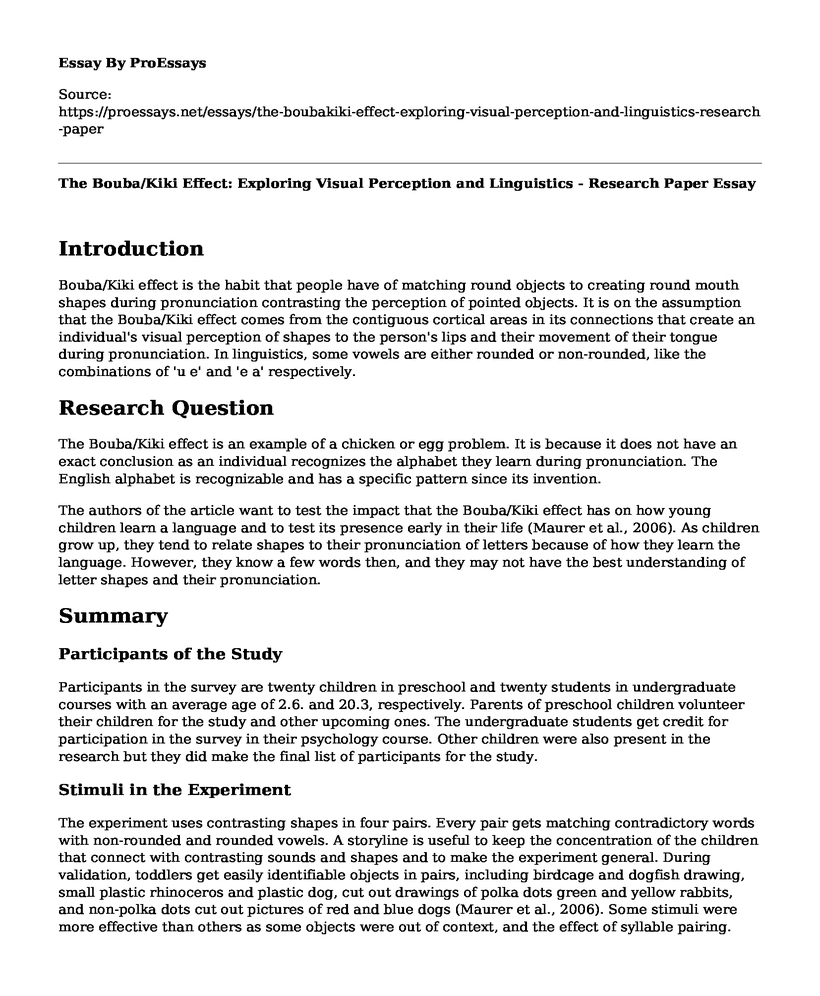Introduction
Bouba/Kiki effect is the habit that people have of matching round objects to creating round mouth shapes during pronunciation contrasting the perception of pointed objects. It is on the assumption that the Bouba/Kiki effect comes from the contiguous cortical areas in its connections that create an individual's visual perception of shapes to the person's lips and their movement of their tongue during pronunciation. In linguistics, some vowels are either rounded or non-rounded, like the combinations of 'u e' and 'e a' respectively.
Research Question
The Bouba/Kiki effect is an example of a chicken or egg problem. It is because it does not have an exact conclusion as an individual recognizes the alphabet they learn during pronunciation. The English alphabet is recognizable and has a specific pattern since its invention.
The authors of the article want to test the impact that the Bouba/Kiki effect has on how young children learn a language and to test its presence early in their life (Maurer et al., 2006). As children grow up, they tend to relate shapes to their pronunciation of letters because of how they learn the language. However, they know a few words then, and they may not have the best understanding of letter shapes and their pronunciation.
Summary
Participants of the Study
Participants in the survey are twenty children in preschool and twenty students in undergraduate courses with an average age of 2.6. and 20.3, respectively. Parents of preschool children volunteer their children for the study and other upcoming ones. The undergraduate students get credit for participation in the survey in their psychology course. Other children were also present in the research but they did make the final list of participants for the study.
Stimuli in the Experiment
The experiment uses contrasting shapes in four pairs. Every pair gets matching contradictory words with non-rounded and rounded vowels. A storyline is useful to keep the concentration of the children that connect with contrasting sounds and shapes and to make the experiment general. During validation, toddlers get easily identifiable objects in pairs, including birdcage and dogfish drawing, small plastic rhinoceros and plastic dog, cut out drawings of polka dots green and yellow rabbits, and non-polka dots cut out pictures of red and blue dogs (Maurer et al., 2006). Some stimuli were more effective than others as some objects were out of context, and the effect of syllable pairing. Some shapes are unique in their details and not their form.
Main Findings of the Experiment
The Bouba/Kiki phenomenon is evident in both children and adults. The children in the experiment match round shapes to rounded vowels and angular shapes to non-rounded vowels (Maurer et al., 2006). It reflects in their average final score and the ensuing trials. The third trial contrasts with the others as the storyline has less effect, and the pairing of consonants and vowels affects their outcome. However, the consistency of matching shapes to pronunciation is still noticeable in the children.
Conclusion
There is a mapping of words with pronunciation explaining the Bouba/Kiki effect. Mapping is useful to help children master a language despite its bias. More research on children's understanding of shapes before they start learning a language is essential. The Bouba/Kiki effect is more evident in rounded vowels versus rounded shapes showing that they can be useful for words exhibiting more rounded vowels than unrounded ones.
References
Maurer, D., Pathman, T., & Mondloch, C. J. (2006). The shape of boubas: Sound-shape correspondences in toddlers and adults. Developmental Science, 9(3), 316-322. https://doi.org/10.1111/j.1467-7687.2006.00495.x
Cite this page
The Bouba/Kiki Effect: Exploring Visual Perception and Linguistics - Research Paper. (2023, Jun 22). Retrieved from https://proessays.net/essays/the-boubakiki-effect-exploring-visual-perception-and-linguistics-research-paper
If you are the original author of this essay and no longer wish to have it published on the ProEssays website, please click below to request its removal:
- Student Views on Minimizing Plagiarism Essay
- Stance Essay Example: Media and Young Minds
- Essay Example: What Is Home? My Perspective on the Meaning
- Zone of Proximal Development: Benefits for Teaching - Essay Sample
- Essay Example on Building Positive Relationships to Foster Healthy Child Development
- Essay Example on Houston ISD: A Leader in US Education Excellence
- Special Education for Children With Special Needs - Essay Sample







